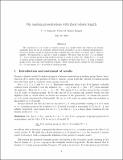Files in this item
On random presentations with fixed relator length
Item metadata
| dc.contributor.author | Ashcroft, Calum | |
| dc.contributor.author | Roney-Dougal, Colva Mary | |
| dc.date.accessioned | 2021-01-19T00:36:07Z | |
| dc.date.available | 2021-01-19T00:36:07Z | |
| dc.date.issued | 2020-01-19 | |
| dc.identifier | 263920476 | |
| dc.identifier | 4ee1b194-a7ec-4ecb-af79-8950f68ac90b | |
| dc.identifier | 85078286313 | |
| dc.identifier | 000508066000001 | |
| dc.identifier.citation | Ashcroft , C & Roney-Dougal , C M 2020 , ' On random presentations with fixed relator length ' , Communications in Algebra , vol. Latest Articles . https://doi.org/10.1080/00927872.2019.1710161 | en |
| dc.identifier.issn | 0092-7872 | |
| dc.identifier.other | ORCID: /0000-0002-0532-3349/work/73700932 | |
| dc.identifier.uri | https://hdl.handle.net/10023/21286 | |
| dc.description.abstract | The standard (n, k, d) model of random groups is a model where the relators are chosen randomly from the set of cyclically reduced words of length k on an n-element generating set. Gromov’s density model of random groups considers the case where n is fixed, and k tends to infinity. We instead fix k, and let n tend to infinity. We prove that for all k ≥ 2 at density d > 1/2 a random group in this model is trivial or cyclic of order two, whilst for d < 1 such 2 a random group is infinite and hyperbolic. In addition we show that for d < 1/k such a random k group is free, and that this threshold is sharp. These extend known results for the triangular (k = 3) and square (k = 4) models of random groups. | |
| dc.format.extent | 15 | |
| dc.format.extent | 297674 | |
| dc.language.iso | eng | |
| dc.relation.ispartof | Communications in Algebra | en |
| dc.subject | Finitely-presented groups | en |
| dc.subject | Random presentations | en |
| dc.subject | Hyperbolic groups | en |
| dc.subject | Random graphs | en |
| dc.subject | QA Mathematics | en |
| dc.subject | T-NDAS | en |
| dc.subject.lcc | QA | en |
| dc.title | On random presentations with fixed relator length | en |
| dc.type | Journal article | en |
| dc.contributor.institution | University of St Andrews. Pure Mathematics | en |
| dc.contributor.institution | University of St Andrews. Centre for Interdisciplinary Research in Computational Algebra | en |
| dc.contributor.institution | University of St Andrews. St Andrews GAP Centre | en |
| dc.identifier.doi | 10.1080/00927872.2019.1710161 | |
| dc.description.status | Peer reviewed | en |
| dc.date.embargoedUntil | 2021-01-19 |
This item appears in the following Collection(s)
Items in the St Andrews Research Repository are protected by copyright, with all rights reserved, unless otherwise indicated.

